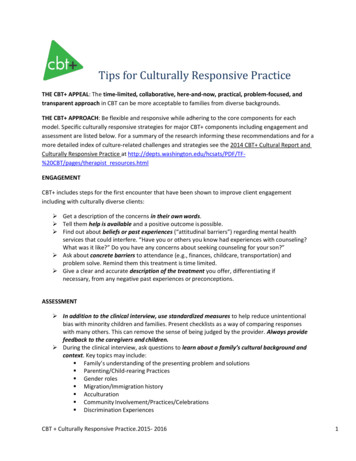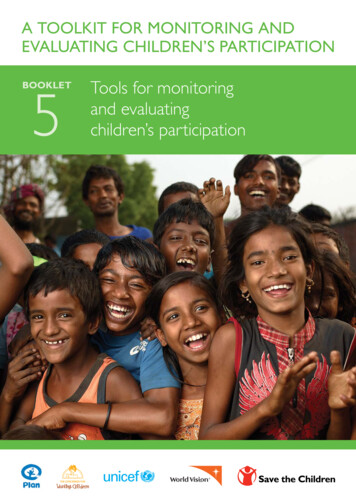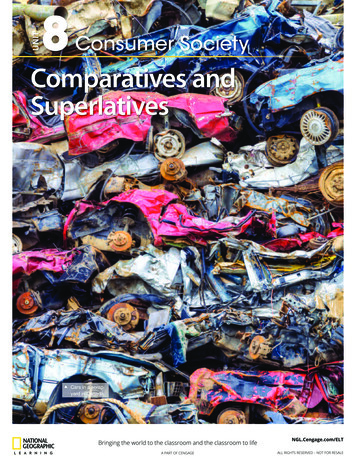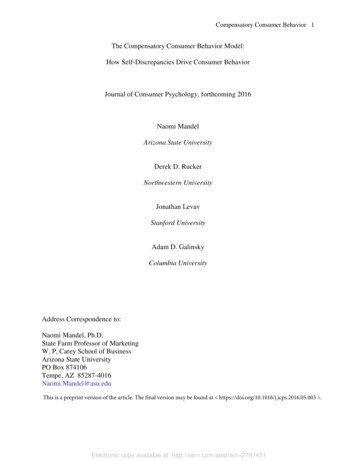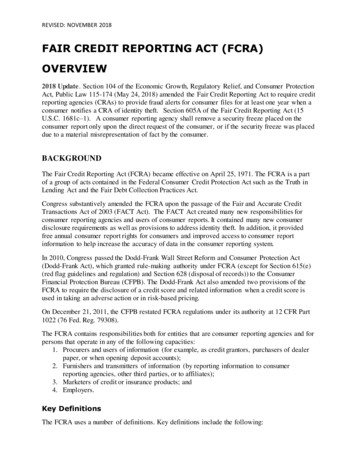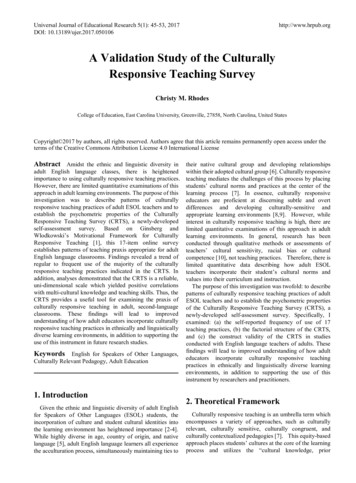
Transcription
Consumer Participationand Culturally andLinguistically DiverseCommunities
Consumer Participation and Culturally and Linguistically Diverse roduction8Themes- Organisational Commitment- Cultural and Linguistic Appropriateness- Support and Mentoring for Consumers- Representative Consumers- Ethics, Power, Equality and Reciprocity- Levels and Degrees of Participation15 Case Studies- The Family Understandings Project: Mental Health and Horn of Africa Communities- Mismatched Caring: The Multicultural Challenge- The Spectrum of Cultures Group: Giving Mental Health Consumers Voice,Visibility and Respect in Society- Diversity and Disability: Be the Changes You Want- Healthy Ageing though Exercises and Healthy Eating- Ageing, Participation and Wellbeing: The Village Glee Club Intergenerational Choir22 Resources- A Practical Guide to CALD Consumer Participation- Making Focus Groups Culturally and Linguistically AppropriatePublished by the Centre for Culture Ethnicity & Health, Melbourne, Victoria, Australia.This report is available at the Centre for Culture Ethnicity & Health’s website www.ceh.org.au/resources/resbyceh.html 2005 Centre for Culture Ethnicity & Health, Melbourne, Australia.Designed by Morgan Sideris P/L
Consumer Participation and Culturally and Linguistically Diverse Communities2AcknowledgementsContributorsThe Centre for Culture Ethnicity & Health (CEH) would like to thank the following individuals andorganisations for their contributions to this project:Ania Sieracka, Australian Polish Community Services; Cara Brough; CEH Stakeholders Group;Nancie-Lee Robinson, Centre for Culture Ethnicity and Health; Jackie Mansourian, Darebin CommunityHealth; Department of Human Services – Primary and Community Health Branch; Maria Dimopoulos,Myriad Consultants; Ethnic Communities’ Council Victoria; Health Issues Centre; Pamela Freeman, JewishCare; Effie Meehan and Christian Astourian, Migrant Resource Centre North West; Serap Ozdemir andMaria Garzo, Moonee Valley Melbourne PCP/Aged Services Network; Nicki Sideris, Morgan Sideris P/L;Jane Price, North Richmond Community Health Centre; Liz Young, Royal Children’s Hospital; ProfessorColleen Stainton, Royal Hospital for Women and University of Sydney; Phong Nguyen, Springvale IndoChinese Mutual Assistance Association/Ethnic Communities’ Council Victoria; Dr Deborah Warr, Universityof Melbourne; Dr Helen Szoke, Victorian Equal Opportunity Commission; VicHealth; Beth Wilson, VictorianHealth Services Commissioner; Padma Raman, Victorian Law Reform Commission; Commissioner GeorgeLekakis, Victorian Multicultural Commission; Evan Bichara, Victorian Transcultural Psychiatry Unit; VITSLanguageLink; Clare Amies, Western Region Health Centre; Eggie Chanyalew, Etenesh Woldemariamand Ayuel Bulkoch, Western Region Health Centre; Linda Williamson; and Dr Perla Protacio, WyndhamCity Council.Conference Steering CommitteeAmy Kirwan, Centre for Culture Ethnicity & HealthLidia Horvat, Centre for Culture Ethnicity & HealthJudy McDougall, Migrant Information Centre (Eastern Melbourne)Jaime Timmerman, Western Region Health CentreKris Pavlidis, City of WhittleseaPanayiota Romios, Health Issues CentreDr Prabir Majumdar, Ethnic Communities’ Council VictoriaAbbreviationsCEH Centre for Culture Ethnicity & HealthCALD Culturally and Linguistically Diverse/Cultural and Linguistic DiversityDHS Department of Human Services
Consumer Participation and Culturally and Linguistically Diverse Communities3[To create services that are truly focussed on the needs ofthe communities, it is essential that organisations engagethe broad spectrum of local consumers.ForewordThe Multicultural Victoria Act 2004 states that all Victorians are equally entitled to access opportunitiesand participate in the social, cultural, economic and political life of the state. The ways in which healthand community service providers encourage the participation of culturally and linguistically diverse (CALD)communities has an important bearing on the quality of their services.The diversity of consumers from non-English speaking backgrounds is a great challenge to service providers.It also brings the possibility of rich and valuable contributions to health and community organisations. Tocreate services that are truly focussed on the needs of the communities, it is essential that organisationsengage the broad spectrum of local consumers.This report encourages critical reflection of the effectiveness of current consumer participation strategiesto engage culturally and linguistically diverse consumers. Identifying some of the critical success factorsand challenges in working with CALD communities, the report presents a model for good practice aswell as case-study examples of work undertaken in the health and community sector.We hope that this report will assist organisations to reflect on their current practice and build their capacityto implement culturally and linguistically inclusive consumer participation strategies.George LekakisChairpersonVictorian Multicultural Commission]
4[CALD consumers make up approximately 25% of the Victorianpopulation. Accordingly CALD consumers need to be activelyengaged by health and community organisations to ensurethat service and program models meet the needs of a quarterof the population.Introduction]
Consumer Participation and Culturally and Linguistically Diverse Communities5IntroductionConsumer participation in health care encompasses both current and potential consumers of health services,carers and the wider community participating in decision making about health care. For the health andcommunity sector, the parameters of what constitutes consumer participation are very broad and can includeanything from individual decisions about care to participating in policy, workforce and service development.The evidence supporting consumer participation in health demonstrates that participation: Can lead to more accessible and effective health services1 Is a mechanism to ensure accountability Can improve health outcomes and the quality of services2CALD consumers make up approximately 25% of the Victorian population3. Accordingly, CALD consumersneed to be actively engaged by health and community organisations to ensure that service and programmodels meet the needs of a quarter of the population.The participation of individuals and communities can be influenced by a variety of factors from personalpreference to socioeconomic circumstances. For CALD consumers, their ability to participate may belimited by such things as language proficiency, migration experience, social isolation, other personalpriorities such as housing and employment and lack of familiarity with meeting structures and theAustralian health system. These factors must be considered in order to determine the relevance ofa particular participation strategy to CALD consumers and communities.‘Consumer participation’ is used in this report to broadly describe processes of community participation,carer participation, patient-centred care or client participation. CEH has chosen the term consumerparticipation as it is most commonly used in academic literature on participation in health.Purpose of the ReportThe purpose of this report is to present findings from a conference that CEH held in September 2005which was called Consumer Participation and Culturally and Linguistically Diverse Communities: WorkingTogether Towards Good Practice. The aim of the conference was to explore ways in which health andcommunity organisations facilitate and support the participation of CALD consumers in the planning,implementation and evaluation of services, programs and projects.The report discusses some of the areas of CALD consumer participation that could be reflected upon whendesigning and implementing effective strategies. The themes in this report are supported by a series of casestudies which demonstrate how a health or community organisation has worked with CALD communitiesand consumers. These case studies were drawn from presentations at the conference.1National Resource Centre for Consumer Participation in Health The Evidence Supporting Consumer Participation in Health, Bundoora,Latrobe University, 20012Metropolitan Health and Aged Care Services Division Participation in your health service system: Victorian consumers, carers and the community workingtogether with their health service and the Department of Human Services, Melbourne: State of Victoria, Department of Human Services, 20053Victorian Office of Multicultural Affairs Website www.voma.vic.gov.au
Consumer Participation and Culturally and Linguistically Diverse Communities6IntroductionThe report also highlights that many key tensions and gaps exist in participatory practice. A variety ofchallenging ethical concerns have been noted by the practitioners and consumers that contributed to thisreport. The gap between organisational rhetoric and what is actually happening on the ground has also beenpointed to as an area of concern. This is consistent with the policy context of consumer participation, whichwas described in a discussion paper written by the Department of Human Services (DHS) early in 20054. Thepaper indicated that current policy directions on consumer participation are somewhat fragmented, occurringin a variety of different policy documents, but with no overarching policy to draw these together. DHS iscurrently developing a whole of department policy for consumer participation which will hopefully supporta more comprehensive and structured approach to consumer participation in the health and community sectors.The report is written from an organisational point of view, as most of the information gathered was fromworkers who had developed and implemented participation strategies. The CALD consumer perspectiveof participation still needs to be explored more fully as the current agenda for CALD consumer participationtends to be service driven. CEH is hoping to develop a complementary resource to this report in the futurewhich reflects CALD consumer perspectives of consumer participation.For some readers, this report may offer more questions than it answers. It is not an exhaustive accountof all the issues that need to be addressed in working with CALD consumers. Rather, it is designed toguide organisations along a path of reflection about the opportunities, benefits and challenges of CALDconsumer participation.MethodologyEach year, CEH conducts a Good Practice Project to explore and promote good practice that aims toenhance the health and well-being of Victoria’s CALD communities. Consumer participation (along withlanguage services) was one of the areas that CEH identified for 2004-05 after emerging as a key issuefor services in the Community Health Service Needs Analysis conducted by CEH in 2004.In conducting a literature review on this subject, CEH found a lack of documented practice examples.A conference was identified by CEH as a way for workers to share their experiences, identify gaps andwork together towards good practice. The rationale was that, in turn, this would provide an opportunityfor practice examples to be documented and disseminated more widely.A steering committee was set up to guide the overall direction of the conference and provide expertiseon key areas of CALD consumer participation. Representatives were invited from community health, anethnic community organisation, a migrant settlement service, a key consumer participation organisation,local government and from within CEH in order to elicit a range of perspectives. The committee discussedhow best to gather examples of practice which could demonstrate critical success factors, challenges andkey learnings in CALD consumer participation.Following the first meeting of the committee, a Call for Submissions was developed and sent out to healthand community organisations, contacts in government and consumer organisations so that they couldnominate their work with CALD consumers as an example of good practice.4Metropolitan Health and Aged Care Services Division Participation in your health service system: Victorian consumers, carers and the community workingtogether with their health service and the Department of Human Services, Melbourne: State of Victoria, Department of Human Services, pate.pdf
Consumer Participation and Culturally and Linguistically Diverse Communities7[A conference was identified by CEH as a way forworkers to share their experiences, identify gapsand work together towards good practice.This yielded a small number of submissions, of which ten were selected by the committee to be presentedat the conference. Again, there seemed to be a lack of practice examples which could be assessed todetermine what good practice might be.Selection of submissions was based on the range and complexity of different strategies described, withthe understanding that a variety of approaches could encompass good practice. Keynote speakers andpanel members were also invited to share their experiences of CALD consumer participation to broadenthe strategies and viewpoints being presented.The conference took place in September 2005 and was attended by around 140 people. Informationfrom presentations, discussions at the conference and consultations with presenters and experts in thefield has been synthesised to produce this report. Both consumers and workers have contributed to thedrafting of the report.Structure of the ReportBased on information gathered through the conference, CEH has identified a thematic way for organisationsto reflect on culturally and linguistically appropriate consumer participation. The ‘Themes’ section of thereport consists of six major considerations for health and community service providers wanting to effectivelyengage with CALD consumers.The themes of the report are as follows:1. Organisational Commitment2. Cultural and Linguistic Appropriateness3. Support and Mentoring for Consumers4. Representative Consumers5. Ethics, Power, Equality and Reciprocity6. Levels and Degrees of ParticipationThe organisational commitment theme provides a context for the rest of the report by demonstratinghow consumer participation needs to be co-ordinated, resourced and supported in an organisation inorder for it to be successful.Case StudiesThe themes listed above are followed by a selection of case studies which highlight how particularorganisations have approached working with CALD consumers. While the case studies do touch onparticular themes, they address a variety of considerations which are discussed throughout the report.They are intended to demonstrate that there are diverse ways in which organisations can facilitate theinvolvement of CALD consumers and each has individual challenges and benefits.For reasons of space and clarity, not all case studies which were presented at the conference have beenincluded here. Those that have been selected represent a range of organisations, projects and programs,different stages of implementation and with different degrees of participation.For more information about any of the case studies described, please contact CEH or refer to the contactdetails on particular case studies where these are provided.]
8][A key consideration in developing a CALD consumer participationstrategy is how well placed the organisation is to respond tothe needs identified by communities and what capacity theorganisation has to support consumer-driven initiatives.Themes
Consumer Participation and Culturally and Linguistically Diverse Communities9ThemesOrganisational CommitmentCEH’s research has demonstrated that there is a gap between organisational rhetoric about commitmentto CALD consumer engagement and participation, and the dedication of resources or the organisationalknow-how to make it happen effectively.Workers consistently grapple with the notions of ethics, power, equality and reciprocity as they try todetermine what constitutes genuine participation, and how true partnership can occur when the agendais determined by the service provider.A key consideration in developing a CALD consumer participation strategy is how well placed theorganisation is to respond to the needs identified by communities and what capacity the organisationhas to support consumer-driven initiatives. How will the organisation manage where its own prioritiesare different to those of particular CALD communities? Negotiating the gaps with sensitivity, respectand a clear understanding of the organisational limitations will be crucial to the success of participation.Briefing the community clearly on the scope of a project or program will possibly reduce unrealisticexpectations and disillusionment and allow them to be practical and solution-focused.Building organisational capacity to develop and implement effective CALD consumer participation strategiesinvolves exploring a range of key issues. CEH research has shown that an organisation needs to: Be clear about why consumer participation is important and what the organisation wants to achieveby including consumers. This bigger picture view needs to be communicated and understood acrossthe entire organisation. Know who their CALD consumers are, both current and potential clients. Consider what level and degrees of participation will be most appropriate to achieving the goals ofthe organisation and those of the community. Map current CALD consumer participation across the organisation – is there duplication of effort?Are there opportunities? Is the range and scope of consumer participation across the organisationknown and coordinated? Are there areas of the organisation implementing effective consumerparticipation strategies? If so, how are these being captured so that learnings can be shared acrossthe organisation? Ensure that staff have appropriate skills, experience and confidence – this might mean an understandingof cultural and linguistic appropriateness, considerations for mentoring and supporting CALD consumersand knowledge of methods of participation. Build and maintain ongoing links with ethno-specific organisations and community and culturalassociations to facilitate meaningful partnerships. Determine what organisational supports are needed to create an environment that enables effectiveconsumer participation – for example, language services, policies, procedures, coordination, evaluationand quality improvement mechanisms, and resource allocation.
Consumer Participation and Culturally and Linguistically Diverse Communities10ThemesCultural and Linguistic AppropriatenessDeveloping a strategy that is appropriate to the cultural background and language preferences and skillsof consumers is an important first step.LanguageIn order to engage consumers with low English proficiency, communication must occur in the preferredlanguage of the consumer. This can be done through interpreters or bilingual workers, or translationsmay be utilised if the literacy of the consumers in their first language is sufficient. There may also be arange of languages or dialects that could be spoken by consumers from a particular country of origin andorganisations might have to cater accordingly when planning to meet language needs. Prior research orconsultation will help to determine which languages are appropriate.CultureSome participation methodologies will not be appropriate for all groups due to cultural differences. Askingfor individual opinions or feedback may not be a good fit with the collective orientation of some cultures.Satisfaction surveys may only elicit positive feedback from some CALD consumers, regardless of negativeexperiences. What might be considered traditional practices may not be appropriate for all CALD consumers ina particular community. Replicating practices from the country of origin may not take into account that theseare considered unjust by some members of the community, who may feel marginalised in their own community.Examples of this might include how the status of women can differ in other cultures. The key is to check what ispreferred and appropriate with the consumer and, if possible, let them shape how their participation might occur.Targeting StrategiesThe target group of a participation strategy could be based on country of origin, language spoken, ethnicity,gender, age, illness/condition or any other relevant variable. Selecting people from a particular languagegroup to be targeted will not necessarily mean that they are a defined community who have links withone another and the same view of their culture. While it is easy for organisations to target, for example,the ‘Vietnamese Community’, in reality this so-called community may be very dispersed. Individuals maynot want to identify themselves as belonging to that community and ‘community members’ may beethnically diverse. There may well be considerable gaps in a sense of community belonging betweendifferent generations. Acknowledging the diversity and complexity that exists within all groups will beimportant for determining how to target a particular strategy.The political and historical background of CALD communities can also be researched to determine whetherany past conflicts or events might influence the targeting of a particular group. Recent arrivals from theformer Yugoslavia, for example, may need to be targeted in different and separate ways to encouragetheir participation, given the political context of their migration and their ethnicity. People from migrationstreams such as humanitarian entrants and skilled migrants may also need to be targeted in different waysas their needs may vary given the context of their migration.A Variety of StrategiesThe diversity of CALD consumers can sometimes be obscured by the use of the banner term ‘CALD’, whichseems to imply one strategy for all people from non-English speaking backgrounds. Offering consumers arange of ways that they could become involved in the development of services and programs has a greaterchance of meeting their needs and enabling their participation. This could mean offering options such asfocus groups, surveys, community meetings, committee membership and informal interviews.
Consumer Participation and Culturally and Linguistically Diverse Communities[Acknowledging the diversity andcomplexity that exists within all groupswill be important for determining howto target a particular strategy.Support and Mentoring for ConsumersProviding support to consumers which assists them to participate, as well as acting as a mentor so thatconsumers can develop skills and knowledge, provides consumers with a greater opportunity to participatein a sustained and meaningful way.Types of SupportSupport for CALD consumers may be different than that needed by other consumers due to their individuallanguage needs, migration history, knowledge of the health system or cultural values and beliefs. Whatlevel and type of support is required will need to be established by working with the individual consumer.Mentoring a consumer to develop their knowledge of committee structures or the nature of the healthsystem or service provider may mean the difference between meaningful participation and the consumernot being able to contribute at all. Health systems in other countries may be vastly different, so the conceptof consumer participation itself may be very unfamiliar.Briefing consumers prior to meetings and providing an environment where the consumer feels supported tospeak up will be extremely important. Many CALD consumers may not want to speak up for fear of retributionor having services withdrawn, particularly where they have come from countries where government corruptionis common. This fear can be countered by working with the consumer to develop their understanding ofhow participation processes operate and what the outcomes might look like. The benefits of support arewidespread and can include building the skills of consumers so that they have greater opportunities foremployment and higher confidence and self-esteem.Support such as reimbursement and opportunities for training are not CALD-specific, but are integral toeffectively engaging CALD consumers. Reimbursement may be particularly important in smaller communitieswhere there may be ongoing opportunities for participation and input, but only a few in the communitywho are able to commit their time due to other issues being a priority, such as housing and employment.CommunicationThe use of terminology, acronyms and jargon may discourage CALD consumers from fully participating.Support in either making the definitions of different terminology clear or refraining from using jargonat all will help enable CALD consumers to participate more effectively.Professional ConsumersOrganisations often look for an ‘authentic’ consumer who speaks as a member of a community on particulartopics. Over time, through a process of participation, support and mentoring, organisations may find thatconsumers become more ‘professional’. As their knowledge and skills in participation grow, this doesn’tnecessarily correspond with a decrease in their ability to provide a consumer viewpoint. The apparentprofessionalisation of consumers is not negative. Rather, they will have a wider range of skills and abilitieswhich could be employed in participation processes.]11
Consumer Participation and Culturally and Linguistically Diverse Communities12ThemesRepresentative ConsumersRepresentation means being able to speak on behalf of a particular group of people and provide their viewson particular issues. While representation can be an important part of consumer participation, as it is notpossible to obtain and include the views of every consumer or community member, how it occurs and forwhat purpose requires consideration.Community LinksWhen using a representative of a specific CALD community, or CALD communities in general, organisationsneed to have an understanding of the links between the representative and the community being represented.How well connected is the consumer to their community? How will feedback and consultation occur? Howoften will it occur? Is the representative being supported by the organisation to consult with communitieson an ongoing basis? Answers to these questions will provide a context for the nature of the representationthat is occurring.Diverse ViewsThe diversity within CALD communities is high, so the views of all community members cannot berepresented by a small number of people. Furthermore, community views may be conflicting and diverse.Asking one consumer to represent others entails providing them with an understanding of whether topresent the most dominant view in a community, to talk about the spectrum of viewpoints or think aboutwhich views might be marginalised. When asking a representative to provide a cultural perspective, it mustalso be understood that there are diverse perspectives on particular cultures. Culture itself is dynamic andchanges with migration experiences, time spent in different countries, generations and interaction withother cultures.Over-Representation, Marginalisation and FatigueOrganisations may find that the same representatives are continually participating. This may happen dueto their knowledge of participatory structures, their English proficiency or their status in their community.While they may be a vibrant and dedicated representative, it must also be established whether the viewsof others are being heard. The specific target group being represented (e.g. women, the elderly, youth,people with a particular illness, etc) needs to be made clear both by the organisation and the representative.Representation may give the illusion of inclusion.Individual representatives may also lose enthusiasm for their role over time, but feel they must to continuedue to community or agency demands. Over-representation by the same individuals or groups may lead towhat is referred to as ‘consumer fatigue’, so having a variety of people that can represent community viewsmay assist in sustaining input over time. Fatigue may need to be recognised and managed by organisationsdue to the obligations felt by consumers to the community they are representing. This could happen throughregulating the amount of time a representative sits on a particular committee or group or rotating differentrepresentatives through different functions, or through a co-ordinated approach to consumer participationat the whole of organisation level.
Consumer Participation and Culturally and Linguistically Diverse Communities[The community needs to benefit equally and tangiblyto maintain a good relationship with the organisationand not become disillusioned by providing their timeand resources to support organisational practices.Ethics, Power, Equality and ReciprocityEthical considerations are integral to determining how participation is facilitated and sustained. Thesemight include thinking about where power lies, how resources can be shared and whether benefits andcontributions are reciprocal.Community HierarchiesGiving some consumers the opportunity to provide their opinion, perhaps due to their English proficiencyor ‘leader’ status, and not others, can create a hierarchy within communities that can disturb or compoundcommunity structures. This can particularly be the case where mentoring and support is provided to individualconsumers. This doesn’t mean that mentoring and support shouldn’t be provided, just that the organisationneeds to understand what effect participation could have on a CALD community as a whole.The organisation’s understanding of a CALD community will influence which channels they approach thecommunity through and whether they call on ‘leaders’ to participate. Community leaders may not ‘lead’all those in what appears to be a designated community. Selection of participants needs to take accountof the relationship
guide organisations along a path of reflection about the opportunities, benefits and challenges of CALD consumer participation. Methodology Each year, CEH conducts a Good Practice Project to explore and promote good practice that aims to enhance the health and well-being of Victoria's CALD communities. Consumer participation (along with

